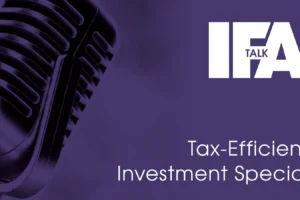We brought you pre-end-of-tax year advice, and now it’s time to look forward past the 6th of April and toward new planning opportunities. The new tax year is not just about compliance; it’s an opportunity to revisit client strategies, optimise tax efficiency, and ensure financial plans remain aligned with evolving regulations. With changes to capital gains tax, pension allowances, and inheritance tax rules on the horizon, advisers have much to address with their clients in 2025.
Cameron Stewart, Chartered Financial Planner at Aberdeen Considine Wealth, states: “Now’s the perfect time for some smart financial planning with clients. Here’s what should be top of the priority list.”
Maximising allowances early
The beginning of the tax year is the ideal time to ensure clients utilise key allowances before the year-end rush. The earlier investments are structured correctly, the greater the potential tax efficiencies throughout the year.
Optimising pension contributions
The annual pension allowance remains at £60,000, offering a significant tax-efficient saving opportunity. However, high earners must be mindful of the tapered annual allowance, which reduces the allowance for those who have adjusted income over £260,000 and threshold income over £200,000.
Additionally, advisers should revisit pension strategies following the announcement that discretionary pension scheme death benefits will be subject to IHT from 2027.
Mark Devlin, Senior Technical Manager at M&G, explains: “There will be clients who have overfunded pensions and who were never going to touch their pension savings to fund their own retirement and who may need to act. This is what we refer to as their ‘red’ money, money that a client is never going to need during their lifetime and that could now be in danger of paying IHT.”
Furthermore, pension contributions offer additional tax advantages, particularly for higher-rate taxpayers. A £10,000 pension contribution from a 40% taxpayer effectively costs just £6,000 after tax relief, making pensions one of the most efficient ways to save for the future.
Frontloading ISA contributions
The ISA allowance remains at £20,000, and frontloading contributions can maximise the benefits of tax-free compounding. Given the reduced dividend and CGT allowances, shifting investments into ISAs early in the tax year can shield income and gains from tax liability.
Ben Lester, Head of Distribution at Morningstar Wealth, highlights: “More individuals are likely to face tax liabilities thanks to the CGT and dividend allowance cuts, making it more important than ever to encourage people to use their ISA and pension allowances fully.”
CGT and investment wrappers
CGT planning is becoming more urgent, with the annual exemption now at £3,000 (down from £6,000 in 2023/24). Clients with large, unwrapped investment portfolios should review options such as general investment accounts (GIAs), onshore/offshore bonds, and multi-asset funds, which can mitigate tax liabilities.
Devlin notes: “Gains from unwrapped investments become taxable above the annual exempt amount of £3,000, and following the 2024 autumn budget higher rate taxpayers will now pay 24% on these gains (18% for basic rate). This means that gains above £18,000 are taxed less in an onshore bond—taxed at 20% in the bond, less some allowances.”
IHT and estate planning
With growing concerns over future IHT reforms, clients should make full use of gifting allowances:
- annual exemption: £3,000 per year (plus the previous year’s unused allowance)
- small gifts allowance: £250 per recipient
- regular gifts from excess income: not subject to the seven-year rule
Advisers should discuss trusts, gifting strategies, and the impact of the new pension IHT rules with clients. The earlier these plans are implemented, the more effective they can be in reducing taxable estates.
Devlin highlights: “It’s important that clients maximise their available allowances. Having the right funds in the right place can allow a client to make use of their ISA allowance, the starter rate for savings, the personal savings allowance and the dividend nil rate.”
The ‘£100,000 tax trap’
The personal allowance taper, which reduces the £12,570 tax-free allowance by £1 for every £2 of income over £100,000, remains a pressing issue.
Salary sacrifice, pension contributions, and charitable donations can be effective tools to keep income below this threshold.
Stewart advises: “For those earning over £100,000, salary sacrifice, or pension contributions could help retain their £12,570 personal allowance.”
For clients on the cusp of this threshold, deferring income, making pension contributions, or charitable giving can help them retain their personal allowance and reduce their overall tax bill.
The high-income child benefit charge (HICB)
From April 2025, the high-income child benefit charge (HICBC) threshold has increased to £60,000 (from £50,000), with full removal at £80,000. This is a positive change, but clients still need strategies to manage their net adjusted income.
“It’s also worth reminding clients that the HICBC threshold has been raised. It now applies to those earning between £60,000 and £80,000 (up from £50,000 to £60,000),” notes Alex Ranahan, Tax Expert from FSL. “Clients earning above £60,000 could consider increasing their pension contributions or using salary sacrifice to reduce their net income and bring it below the threshold.”
Furnished holiday let changes
From April 2025, FHL tax advantages will be abolished, meaning rental profits will no longer qualify as earned income for pension contribution purposes.
Advisers with property investor clients should discuss alternative tax-efficient investment structures and potential disposals before the new rules take effect.
Keeping clients on track
Beyond tax efficiency, advisers must help clients avoid knee-jerk decisions driven by economic uncertainty. Morningstar Wealth’s research highlights that investors often hire financial advisers for peace of mind as much as financial returns.
Lester explains: “The adviser’s role is as much about making sure clients don’t make wrong decisions as it is making sure they make the right ones. The most vital service an adviser can offer is peace of mind, and with the whole of the new financial year ahead, there is plenty of opportunity to engage with clients, help to reduce those stress levels, and encourage them not to leave important decisions to the last minute.”
Ready, set, go
The new tax year presents advisers with a fresh opportunity to add value for their clients. From maximising tax-efficient allowances and mitigating IHT exposure to navigating CGT and income tax thresholds, early and strategic planning can yield significant benefits.
As Devlin concludes: “In conclusion, the new tax year offers clients the chance to optimise their financial planning. By using available allowances, managing investments wisely, and considering pension scheme changes, clients can maximise their benefits and make informed decisions for the future.”
With the entire tax year ahead, advisers should seize the moment to help clients achieve greater tax efficiency, financial security, and long-term success. Over to you!















